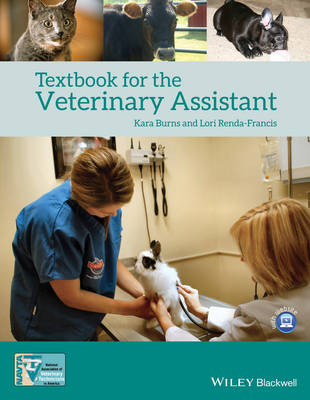(To see other currencies, click on price)
MORE ABOUT THIS BOOK
Main description:
Textbook for the Veterinary Assistant offers a comprehensive guide to the NAVTA-approved curriculum for veterinary assisting programs. Written by leaders in the profession and copublished with NAVTA, the book covers the complete list of NAVTA Veterinary Assistant Essential Skills. Specifically tailored for veterinary assistants and veterinary assistant students, the book uses an engaging writing style to provide a concise, user-friendly approach to the material. With chapters on medical terminology, clinical skills, office procedures, client communication, and more, the book equips veterinary assistants with all the information they need to succeed. A companion website offers interactive multiple-choice questions, the figures from the book in PowerPoint, teaching activities, breed study guides, and a sample cover letter. Textbook for the Veterinary Assistant is a must-have resource for all veterinary assistant students and those studying for the Approved Veterinary Assistant certification exam, and serves as a useful refresher for veterinary assistants in practice.
Contents:
Contributors ix Acknowledgments xi About the Companion Website xiii Chapter 1 Introduction to the Veterinary (or Assistant) Profession 3 References 5 Chapter 2 Medical Terminology 7 Medical terms 7 Prefixes 8 Suffixes 9 Root words 9 Common abbreviations used in veterinary medicine 9 References 10 Chapter 3 Anatomy 11 Anatomical directional terms 11 Skeletal system 13 Branches of science 15 Body systems 15 External anatomy 15 Common veins 16 Muscles 17 Internal organs 17 Urogenital system 18 Internal structures of the thorax 19 Conclusion 19 References 19 Chapter 4 Behavior, Handling, and Restraint 21 Animal body language 21 References 26 Chapter 5 Office Procedures and Telephone Techniques 27 Telephone techniques 28 References 29 Chapter 6 Nutrition 31 Overview 31 Proteins 31 Carbohydrates 32 Fats 32 Vitamins 32 Minerals 32 Water 33 Palatibility 33 Weight management 35 Patient history 35 Body condition scoring 35 Risk factors 37 Assessing the food 37 Summary 38 Suggested reading 38 Chapter 7 Breeds 39 Cat breeds 39 Dog breeds 48 Determine gender in the cat and dog 50 Reference 51 Chapter 8 Breeding and Genetics 53 Introduction 53 The heat cycle 54 Breeding 54 Whelping 55 Necessary human interaction with newborn puppies 56 Warning signs (when to call the vet) 56 Cats 57 Heat cycle 57 Feline breeding process 58 Breeding management 58 References 58 Chapter 9 History Taking and Physical Exams 59 Determining and recoding vitals 59 History and physical exam 60 Chapter 10 Exam Room Procedures 63 Recognizing ectoparasites 63 Nail trimming 63 Ear cleaning 67 Anal glands 68 Bathing animals 69 Chapter 11 Immunology 71 Innate immunity 71 Acquired immunity 72 Cell-mediated immunity 72 Vaccination 72 Vaccine administration routes 73 References 73 Chapter 12 Animal Nursing and Assisting 75 Temperature 75 Pulse 75 Respiration 76 Pain assessment 76 Nutritional assessment 77 General nursing care 77 References 78 Chapter 13 Pharmacology 79 References 81 Chapter 14 Radiology 83 Radiology safety measures and guidelines 83 Cleaning screens 84 Labeling, filing, and storage of radiographs 84 Proper storage of radiographic film 85 Radiographic positioning 85 Conclusion 86 References 86 Chapter 15 Surgical Assisting 87 Introduction 87 The sterilization process 87 Preparing items for the autoclave 87 Wrapping a surgical pack 88 Cold sterilization 88 Instruments 89 Suture Material 90 Gowns and Drapes 90 The sterile field 92 Preparing for surgery 92 Surgical hand scrub 92 Gowning 93 Gloving 93 Opening and passing sterile items 94 Preparing the patient 95 Post-surgical procedures 96 Chapter 16 Avian and Reptile 99 Avian 99 Reptiles 103 References 105 Chapter 17 Equine 107 Skeletal system 107 The digestive tract 109 Nutrition 109 Key nutritional factors for horses 109 Types of feed 110 Behavior and handling 111 Nursing care and husbandry of horses 112 References 113 Chapter 18 Preparing for Internships and Employment 115 Interview 115 Resume writing 115 Cover letter 116 References 117 Chapter 19 Inventory 119 What will be inventoried in your clinic or hospital? 119 A well-run pharmacy 120 The want list 120 The veterinary assistant s role 120 Drug inventory 120 Man versus computer: both needed! 122 Organizing inventory 122 References 122 Chapter 20 Euthanasia and Pet Loss 125 The five stages of grief 127 References 129 Chapter 21 Client Management 131 Evaluating your clients 131 Client management; essential skills for the veterinary assistant 132 Employee roles 132 References 133 Chapter 22 Medical Records 135 References 140 Chapter 23 Occupational Safety and Health Administration 143 What is the occupational safety and health administration? 143 Material safety data sheets 143 OSHA labeling of secondary containers 143 OSHA inspections 144 Common OSHA veterinary violations 144 Fines 144 References 144 Chapter 24 Pet Health Insurance 147 References 148 Glossary 151 Index 159
PRODUCT DETAILS
Publisher: John Wiley & Sons Ltd (John Wiley & Sons Inc)
Publication date: June, 2014
Pages: 176
Dimensions: 219.00 x 278.00 x 10.00
Weight: 528g
Availability: Contact supplier
Subcategories: Veterinary Medicine
Publisher recommends


